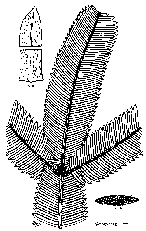
Foliage drawing the The Gardener's Chronicle or April 1903 (4).
Common Names
Phi luoc bí (Vietnamese) (3).Taxonomic notes
Description
Evergreen tree or shrub 5-10 m high and ca. 20 cm dbh with flat, rigid, spreading branches. Branchlets opposite or whorled. Leaves persistent, horizontal, arranged in 2 opposite ranks closely set on the branchlets and curving slightly upwards, 2-3.5 cm long, 3-4 mm wide, linear, rounded or truncate at the base, acute at tip, with midrib somewhat conspicuous or only conspicuous at base or middle part, dark green above, paler beneath, with two glaucous bands of stomata. This arrangement is highly distinctive in the genus, the needles relatively short and set with such precision that they have been likened to the teeth of a comb. Staminate cones 5-7, clustered in a head, 6-9 mm in diameter; stalk about 4 mm long, solitary and axillary. Ovuliferous cones composed of oblong ovoid scales 5 mm long, each scale containing 2 ovules. Drupe obovoid or ovoid, solitary, rarely 2-3 at tip, 2.5-3.5 (-4)cm long and 1-1.5cm across. Flowers in March-May, fruiting in September-October of the next year (2, 3, 4).Range
China: Guangdong, Guizhou, Hubei, Hunan, Jiangxi, Sichuan and Yunnan (5); also placed by some authorities (2, 4) in Thailand; Laos; Vietnam (Lam Dong at altitudes above 950 m), and E India. In China commonly found in rocky places at altitudes to 600 m (2). In Vietnam it grows in subtropical broad-leaved evergreen forest. Shade tolerant when young, intolerant when mature. Very low rates of natural regeneration. Suitable on many kinds of soil (3).Big Tree
Oldest
Dendrochronology
Ethnobotany
The timber is straight-grained with fine structure and high elasticity, rather hard, easy to work, not splitting and deforming after seasoning, and resistant to termites and insects. It is used for high quality furniture, tool handles and fine art articles. Oil from the seeds is used in painting; the seed is also used in medicine (3), and the vegetative parts are rich in anticanger alkaloids (4).Observations
It could probably be found on Emei Shan in Sichuan, where it was discovered by Faber in 1900 (2). The Emei Shan area is world-famous as a site of botanical interest and is a popular destination for foreign travelers. It also should be possible to see at the Bidoup and Langbian Nature Reserves in Vietnam (3); however, I know nothing of the accessibility of these reserves to foreign visitors. It is not recorded as being grown in the U.S. or U.K. (4).Remarks
Endangered thoughout its range (4); listed as threatened/endangered in Vietnam by the World Conservation Monitoring Centre. It requires protection in its natural habitat, especially in the Bidoup and Langbian Nature Reserves (3).Citations
(1) Silba 1986.(2) Dallimore & Jackson 1967.
(3) Forest Inventory and Planning Institute 1996.
(4) Kim E. Tripp. 1995. Cephalotaxus: the plum yews. Arnoldia 55(1): 24-39.
(5) Farjon 1998.
[Cephalotaxus] [Cephalotaxaceae] [home]
This page is from the Gymnosperm Database
URL: http://www.geocities.com/~earlecj/ce/ce/oliveri.htm
Edited by Christopher J. Earle
E-mail:earlecj@earthlink.com
Last modified on 6-Jun-1999